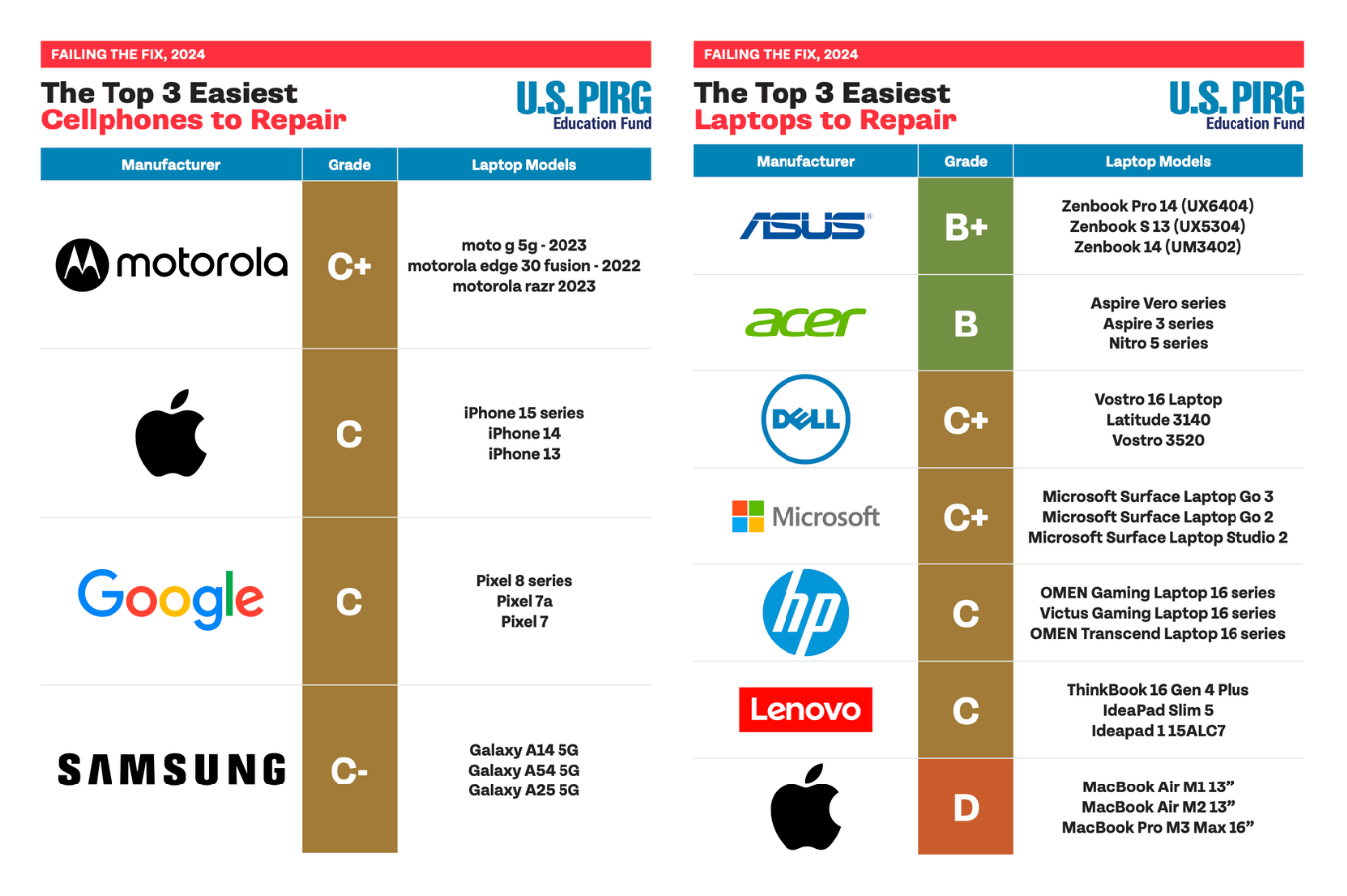
Donate Today
Nobody walks into an electronics store and thinks, “I’m going to buy something that breaks.” Our scorecard helps you choose a repairable phone or laptop from a brand which supports your Right to Repair.
Donate
Many phones and laptops on the market are made to be so difficult to fix they become essentially disposable. We want to choose electronics that are durable and fixable, but how do we know which products are designed to last and which are destined for the dump?
This report calculates a repairability score for the most popular cell phone and laptop brands, and grades which manufacturers are designing devices to last and which are “Failing the Fix.” This year’s scorecard includes a section highlighting the three most repairable cell phones and laptops available on the market from each manufacturer to help you buy a fixable device.

Failing the Fix scorecard grades manufactures how the repairability of their phones and laptops. Click to enlarge.Photo by Alec Meltzer | TPIN
Motorola leads cell phone manufacturers with a C+, while Apple and Google are tied for second place, each earning a C. Samsung lags with a C-. For laptop manufacturers, ASUS leads in repairability with a B+, followed by Acer with a B, DELL and Microsoft are tied for third each scoring a C+ grade, HP and Lenovo follow each earning a C, and Apple is in last place with a D.
You have a right to know if the expensive tech you buy is fixable, especially because, unlike the old saying, you don’t always get what you pay for — at least when it comes to repairability. You should be able to buy products that will last, be repairable when they break, and are made by companies that respect your Right to Repair.
Since January of 2021, France has required companies to provide detailed information about how fixable certain products are, and to post an overall repair score at the point of sale, much like U.S. car fuel economy sticks. Our third edition of “Failing the Fix” reviews the detailed repair information for 164 devices and tracks changes in grades since our last report. This year’s edition also includes a section highlighting the three most repairable cell phones and laptops available on the market from each manufacturer to guide consumers looking to buy a fixable device.
To calculate a final grade we start with the five categories from France’s repair scores. We more heavily weights the disassembly score because we think this better reflects what consumers think a repairability score indicates and because the other categories can be country specific. Consumers’ ability to fix their devices is limited by efforts to stop the Right to Repair, so our final grades remove points from companies who are members of trade groups which lobby against repair legislation. This year’s addition also deducts points if manufacturers don’t easily provide full information on how they calculated their products’ repair scores.
Here’s the breakdown:
Cellphones are improving but laptops are failing the fix. Consumers should choose products from manufactures with the highest fixability grades, and can review the top three most repairable devices from each brand to help them make the right choice.
Repair scores like this provide important information for consumers so they can make the best purchasing choices for their budget. It’s ridiculous to spend hundreds of dollars on expensive tech which is disposable.
The Right to Repair coalition, which includes PIRG, iFixit and Repair.org, has been calling for better access to the parts, tools and information needed to repair modern devices. We’re also advocating for Right to Repair scores to help consumers know which products are fixable before they make an expensive purchase.
Manufacturers should design products that are easier to open up and repair as well as not join trade associations that lobby against the right to repair to improve their scores. Retailers can voluntarily display Right to Repair scores that already exist to provide market transparency. Lawmakers can help by restoring our Right to Repair to ensure that we can fix our stuff, and requiring repair scores so we know which products are designed to last.
Lucas leads PIRG’s Designed to Last campaign, fighting against obsolescence and e-waste and winning concrete policy changes that extend electronic consumer product lifespans and hold manufacturers accountable for forcing upgrades or disposal.
Report ●